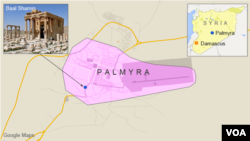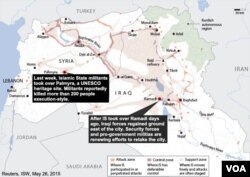The head of UNESCO has called destruction by Islamic State militants in the ancient Syrian city of Palmyra a "war crime."
Militants reportedly blew up the 2,000-year-old Baal Shamin temple on Sunday, nearly a week after beheading Khaled Asaad, archeologist and former head of antiquities in Palmyra who spent decades preserving the site.
“The art and architecture of Palmyra, standing at the crossroads of several civilizations, is a symbol of the complexity and wealth of the Syrian identity and history," UNESCO Director-General Irina Bokova said Monday.
"Extremists seek to destroy this diversity and richness ... [and] I call on the international community to stand united against this persistent cultural cleansing,she added. "[Islamic State] is killing people and destroying sites, but cannot silence history and will ultimately fail to erase this great culture from the memory of the world."
However, several opposition sources told Arab media the Islamic State group destroyed the temple weeks ago. VOA could not independently confirm the claim.
Albert Naccache, a retired history professor from the Lebanese University, told VOA the temple was built in honor of the ubiquitous god “Ba'al” of the Canaanites and Phoenicians.
"The temple that has been destroyed is the temple of Ba'al Shamin, 'the Lord of the Skies,' and it shows that the society was not closed on itself, but open to the general area," he explained. "In fact, at that time, the area around Palmyra was called 'Phoenician-Syria' by the Romans. So, it shows the intermingling of the people of the area."
IS fighters captured the historic town in May, executing more than 200 people in and around Palmyra, sparking fears for the local community and the UNESCO site. The Britain-based Syrian Observatory for Human Rights, which gathers information from sources inside the country, said in June that the militant group had mined the UNESCO World Heritage site.
Syria's antiquities chief Maamoun Abdulkarim told AFP, "our worst fears are sadly being realized."
Throughout Iraq and Syria, Islamic State has targeted art and artifacts, destroying what it deems pagan or sacrilegious from pre-Islamic cultures.
A video released online in February purportedly showed IS fighters toppling ancient statues and chipping away at artifacts with sledgehammers and drills at the Mosul Museum, Iraq's second largest museum.
Archeologists and police abroad are also on the lookout for looted antiquities being sold on the black market amid allegations that Islamic State officials are using plundered items as a revenue stream.
Using satellite images from 2014, the American Association for the Advancement of Science determined five of the six Syrian World Heritage sites sustained visible damage since the country's civil war began in 2011. The study pre-dated, however, the expansion of Islamic State control and the latest destruction.
A museum at Palmyra was emptied before the militants arrived in late May. The move was prompted by previous Islamic State attacks on artwork and artifacts during its campaign to establish a so-called "caliphate" across Syria and Iraq. However, ruins from the ancient city, also known as Tadmur, could not be relocated.
In December, the U.N. said that during Syria's conflicts — which now includes violence from a civil war and the Islamic State group — more than 300 cultural heritage sites have been destroyed, damaged or looted.
The only site that didn't show damage in the AAAS images at the time was the Ancient City of Damascus. Last week, though, a rocket attack on the Damascus Citadel and National Museum damaged the site and killed the Assistant Director of laboratories at Syria's Directorate General of Antiquities and Museums, Qasem Abdullah Yehiya.
"The untimely deaths of Mr. Asaad and Mr. Yehiya are a terrible loss to the cultural heritage community in Syria and globally," the UNESCO Director-General added.
Ed Yeranian contributed to this report from Cairo










